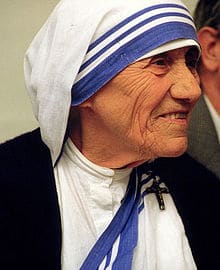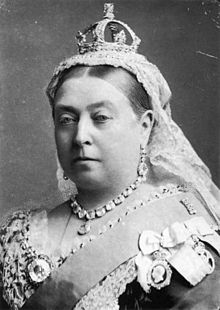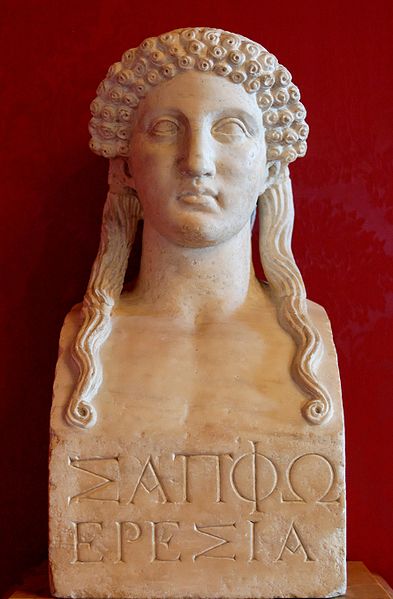Biography Mother Teresa
Mother Teresa (1910–1997) was a Roman Catholic nun who devoted her life to serving the poor and destitute around the world. She spent many years in Calcutta, India where she founded the Missionaries of Charity, a religious congregation devoted to helping those in great need. In 1979, Mother Teresa was awarded the Nobel Peace Prize and became a symbol of charitable, selfless work. In 2016, Mother Teresa was canonised by the Roman Catholic Church as Saint Teresa.
“It is not how much we do,
but how much love we put in the doing.
It is not how much we give,
but how much love we put in the giving.”
– Mother Teresa
Short Biography of Mother Teresa
 Mother Teresa was born in 1910 in Skopje, the capital of the Republic of Macedonia. Little is known about her early life, but at a young age, she felt a calling to be a nun and serve through helping the poor. At the age of 18, she was given permission to join a group of nuns in Ireland. After a few months of training, with the Sisters of Loreto, she was then given permission to travel to India. She took her formal religious vows in 1931 and chose to be named after St Therese of Lisieux – the patron saint of missionaries.
Mother Teresa was born in 1910 in Skopje, the capital of the Republic of Macedonia. Little is known about her early life, but at a young age, she felt a calling to be a nun and serve through helping the poor. At the age of 18, she was given permission to join a group of nuns in Ireland. After a few months of training, with the Sisters of Loreto, she was then given permission to travel to India. She took her formal religious vows in 1931 and chose to be named after St Therese of Lisieux – the patron saint of missionaries.
On her arrival in India, she began by working as a teacher; however, the widespread poverty of Calcutta made a deep impression on her, and this led to her starting a new order called “The Missionaries of Charity”. The primary objective of this mission was to look after people, who nobody else was prepared to look after. Mother Teresa felt that serving others was a fundamental principle of the teachings of Jesus Christ. She often mentioned the saying of Jesus,
“Whatever you do to the least of my brethren, you do it to me.”
As Mother Teresa said herself:
“Love cannot remain by itself – it has no meaning. Love has to be put into action, and that action is service .” – Mother Teresa
 She experienced two particularly traumatic periods in Calcutta. The first was the Bengal famine of 1943 and the second was the Hindu/Muslim violence in 1946, before the partition of India. In 1948, she left the convent to live full-time among the poorest of Calcutta. She chose to wear a white Indian sari, with a blue border, out of respect for the traditional Indian dress. For many years, Mother Teresa and a small band of fellow nuns survived on minimal income and food, often having to beg for funds. But, slowly her efforts with the poorest were noted and appreciated by the local community and Indian politicians.
She experienced two particularly traumatic periods in Calcutta. The first was the Bengal famine of 1943 and the second was the Hindu/Muslim violence in 1946, before the partition of India. In 1948, she left the convent to live full-time among the poorest of Calcutta. She chose to wear a white Indian sari, with a blue border, out of respect for the traditional Indian dress. For many years, Mother Teresa and a small band of fellow nuns survived on minimal income and food, often having to beg for funds. But, slowly her efforts with the poorest were noted and appreciated by the local community and Indian politicians.
In 1952, she opened her first home for the dying, which allowed people to die with dignity. Mother Teresa often spent time with those who were dying. Some have criticised the lack of proper medical attention, and their refusal to give painkillers. Others say that it afforded many neglected people the opportunity to die knowing that someone cared.
Her work spread around the world. By 2013, there were 700 missions operating in over 130 countries. The scope of their work also expanded to include orphanages and hospices for those with terminal illnesses.
“Not all of us can do great things. But we can do small things with great love.”
—- Mother Teresa
Mother Teresa never sought to convert those of another faith. Those in her hospices were given the religious rites appropriate to their faith. However, she had a very firm Catholic faith and took a strict line on abortion, the death penalty and divorce – even if her position was unpopular. Her whole life was influenced by her faith and religion, even though at times she confessed she didn’t feel the presence of God.
The Missionaries of Charity now has branches throughout the world including branches in the developed world where they work with the homeless and people affected by AIDS. In 1965, the organisation became an International Religious Family by a decree of Pope Paul VI.
In the 1960s, the life of Mother Teresa was brought to a wider public attention by Malcolm Muggeridge who wrote a book and produced a documentary called “Something Beautiful for God”.
 In 1979, she was awarded the Nobel Peace Prize “for work undertaken in the struggle to overcome poverty and distress, which also constitutes a threat to peace.” She didn’t attend the ceremonial banquet but asked that the $192,000 fund be given to the poor.
In 1979, she was awarded the Nobel Peace Prize “for work undertaken in the struggle to overcome poverty and distress, which also constitutes a threat to peace.” She didn’t attend the ceremonial banquet but asked that the $192,000 fund be given to the poor.
In later years, she was more active in western developed countries. She commented that though the West was materially prosperous, there was often a spiritual poverty.
“The hunger for love is much more difficult to remove than the hunger for bread.”
-— Mother Teresa
When she was asked how to promote world peace, she replied,”Go home and love your family”.
Over the last two decades of her life, Mother Teresa suffered various health problems, but nothing could dissuade her from fulfilling her mission of serving the poor and needy. Until her very last illness she was active in travelling around the world to the different branches of The Missionaries of Charity. During her last few years, she met Princess Diana in the Bronx, New York. The two died within a week of each other.
Following Mother Teresa’s death, the Vatican began the process of beatification, which is the second step on the way to canonization and sainthood. Mother Teresa was formally beatified in October 2003 by Pope John Paul II. In September 2015, Pope Francis declared:
“Mother Teresa, in all aspects of her life, was a generous dispenser of divine mercy, making herself available for everyone through her welcome and defense of human life, those unborn and those abandoned and discarded,”“She bowed down before those who were spent, left to die on the side of the road, seeing in them their God-given dignity. She made her voice heard before the powers of this world, so that they might recognize their guilt for the crime of poverty they created.”
Mother Teresa was a living saint who offered a great example and inspiration to the world.
Awards given to Mother Teresa
- The first Pope John XXIII Peace Prize. (1971)
- Kennedy Prize (1971)
- The Nehru Prize –“for promotion of international peace and understanding”(1972)
- Albert Schweitzer International Prize (1975),
- The Nobel Peace Prize (1979)
- States Presidential Medal of Freedom (1985)
- Congressional Gold Medal (1994)
- U Thant Peace Award 1994
- Honorary citizenship of the United States (November 16, 1996),
 (1907 – 2003) Multiple Oscar-winning American actress, Hepburn starred in many successful films including The African Queen (1951) The Rainmaker (1956) and On Golden Pond (1981)
(1907 – 2003) Multiple Oscar-winning American actress, Hepburn starred in many successful films including The African Queen (1951) The Rainmaker (1956) and On Golden Pond (1981) Katharine Hepburn was born in Hartford, Connecticut. Her mother, Katharine Martha Haughton was a suffragette, and her strong views and independence influenced the young Katharine. As a teenager, Katharine was free spirited getting involved in sports such as swimming, skating and gymnastics; she had a fearless streak and was suspended from school for smoking and breaking curfew. She later admitted to going swimming naked in the middle of the night. As she later was quoted as saying:
Katharine Hepburn was born in Hartford, Connecticut. Her mother, Katharine Martha Haughton was a suffragette, and her strong views and independence influenced the young Katharine. As a teenager, Katharine was free spirited getting involved in sports such as swimming, skating and gymnastics; she had a fearless streak and was suspended from school for smoking and breaking curfew. She later admitted to going swimming naked in the middle of the night. As she later was quoted as saying: Katherine’s early acting career developed on stage, and from the theatre, she graduated to film. By 1933 she had won her first Oscar for her performance in Morning Glory, a story about a woman who rejects romance for her work.
Katherine’s early acting career developed on stage, and from the theatre, she graduated to film. By 1933 she had won her first Oscar for her performance in Morning Glory, a story about a woman who rejects romance for her work. Edward married Princess Victoria from Germany and the couple had just one child, Alexandrina Victoria, who was born at Kensington Palace in 1819. As a young girl, Victoria’s father died, followed 6 days later by King George III. The throne then passed to King William IV, but, he too died early. This left Victoria to be crowned at the age of 18, in June 1837. Queen Victoria was to reign until her death on 22nd January 1901.
Edward married Princess Victoria from Germany and the couple had just one child, Alexandrina Victoria, who was born at Kensington Palace in 1819. As a young girl, Victoria’s father died, followed 6 days later by King George III. The throne then passed to King William IV, but, he too died early. This left Victoria to be crowned at the age of 18, in June 1837. Queen Victoria was to reign until her death on 22nd January 1901. Mira was born around the start of the 16th Century in the Chaukari village in Merta, Rajasthan. Her father was Ratan Singh a descendent of Rao Rathor, the founder of Jodhpur. When Mirabai was only three years old, a wandering Sadhu came to her family’s home and gave a doll of
Mira was born around the start of the 16th Century in the Chaukari village in Merta, Rajasthan. Her father was Ratan Singh a descendent of Rao Rathor, the founder of Jodhpur. When Mirabai was only three years old, a wandering Sadhu came to her family’s home and gave a doll of 
 Mary Magdalene is mentioned four times in the Gospels as a close devotee of Jesus Christ. She was with Jesus during the crucifixion and the first person to see Jesus after the resurrection. Due to a sermon by Pope Gregory the Great in the sixth century, she developed a reputation as being a prostitute and repentant sinner. However, there is no evidence she was, and it appears there was confusion with other Marys mentioned in the Bible. In the Bahai religion and Eastern orthodox tradition, she is considered a great saint.
Mary Magdalene is mentioned four times in the Gospels as a close devotee of Jesus Christ. She was with Jesus during the crucifixion and the first person to see Jesus after the resurrection. Due to a sermon by Pope Gregory the Great in the sixth century, she developed a reputation as being a prostitute and repentant sinner. However, there is no evidence she was, and it appears there was confusion with other Marys mentioned in the Bible. In the Bahai religion and Eastern orthodox tradition, she is considered a great saint. It is possible that this passage refers to another Mary with (Magdalene) added at a later date. Scholars also suggest that the casting out of demons may have been illness or negative emotions.
It is possible that this passage refers to another Mary with (Magdalene) added at a later date. Scholars also suggest that the casting out of demons may have been illness or negative emotions. Sappho was a female ancient Greek poet who wrote lyrical poetry famous for its intense passion and description of love. Being born on the Isle of Lesbos she is also referred to as the first Lesbian poet.
Sappho was a female ancient Greek poet who wrote lyrical poetry famous for its intense passion and description of love. Being born on the Isle of Lesbos she is also referred to as the first Lesbian poet.